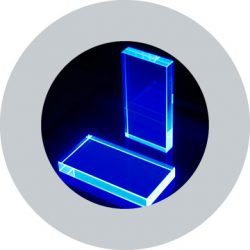Homeland Security – Optimization of Neutron Detection Module based on 6Li-Glass scintillator and an array of SIPMs –NRCN & Ben Gurion University Israel.
NEUTRONS do not interact directly with electrons in matter; therefore, the mechanisms for detecting neutrons are based on indirect methods through nuclear reactions in converter materials. 6-Lithium (6Li) is considered among one of the most effective converters for thermal neutrons. This article investigated the performances of Scintacor’s GS20® 6Li-Glass scintillators coupled to state-of-the-art light sensors, arrays of Silicon Photomultipliers (SiPM). According to set-up models described in this article, Photomultipliers (PMT) light sensors, used for decades, can be effectively replaced with SiPM sensors while maintaining and even improving the detection efficiency and reducing dimensions, weight and energy consumption.[1]
Neutron detection is a key component of applications in national and homeland security, industry, and science. In the last two decades, the need for high sensitivity neutron detectors for Homeland Security (HLS) applications has increased significantly. Therefore, novel technologies and devices are constantly being investigated. Specifically, neutron detectors are important because of their ability to detect small amounts of Special Nuclear Materials (SNMs) that could be used in hostile actions. SNMs are radioactive, and the radiation types that might be detectable a few meters from a hidden source are gamma rays and neutrons. Gamma-ray emissions are plentiful and span a wide range of energies, but they are difficult to distinguish from background gamma radiation and can be easily confused with medical, industrial or Naturally Occurring Radioactive Material sources.
In contrast, neutron detection possesses two intrinsic benefits, a unique signature and long attenuation lengths, also in the gamma-absorbing shield. Therefore, the mere presence of neutrons above background levels is an excellent indicator of SNMs. 3He isotope possess most of the required qualities for slow neutron detection. Therefore, this technology has been for decades the traditional “gold standard” for neutron detection. By far, the most common source of 3He is the decay of tritium. Starting in about 2001, consumption has risen rapidly, greatly surpassing production. Due to the extreme use of this isotope, the global reserves have been practically exhausted. The shortage of 3He has triggered the search for an effective neutron detection alternative.[2].
Li-Glass scintillators coupled to arrays of SiPMs are an effective alternative to the PMT light sensors while maintaining and even improving the detection efficiency and reducing dimensions, weight and energy consumption [1]. Download Full Article

[1] U. Wengrowicz, A. Osvizky, A. Ocherashvili, D. Ginzburg, Y. Ifergan, E Volasky, Y. Kadmon, A. Raveh, I. Orion“Optimization of Neutron Detection Module based on 6Li-Glass scintillator and an array of SIPMs,” EPJ Web of Conferences 225, 07012 (2020)https://doi.org/10.1051/epjconf/202022507012 ANIMMA 2019.
[2].R. C. Runkle, A. Bernstein, and P. E. Vanier, “Securing special nuclear material: Recent advances in neutron detection and their role in nonproliferation,” J. Appl.Phys., vol. 108, no. 11, 2010, Art. no. 111101, doi:10.1063/1.3503495.
Find out more about Scintacor 6-lithium-glass for neutron detection or contact our sales team to discuss your requirements.
You may also be interested in 6-Lithium Enriched Glass Scintillators for High-Flux Neutron Radiography


